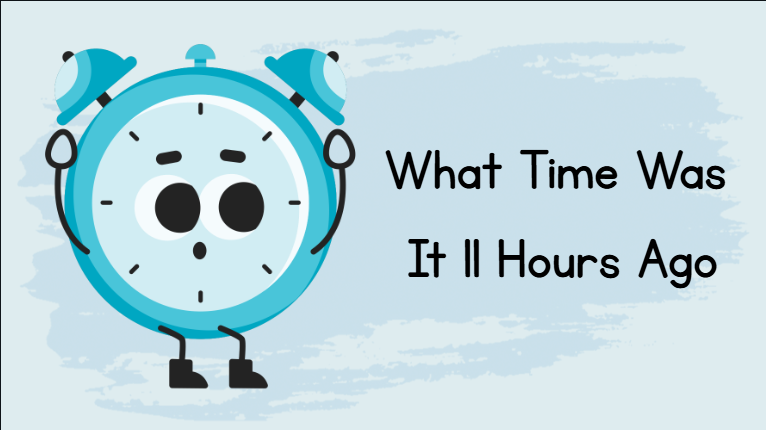Time is a big part of our daily life. We use it to plan our day, finish work, and meet people on time. But sometimes, we may need to know what time it was a few hours earlier. One common question is, what time was it 11 hours ago? This article will explain in simple words how to find the answer, why it matters, and some easy tips to calculate it anytime.
Understanding the Concept of “11 Hours Ago”
When we say “11 hours ago,” we are talking about the time that passed 11 hours before the current time. For example:
- If the time now is 3:00 PM, then 11 hours ago it was 4:00 AM.
- If the time now is 9:00 AM, then 11 hours ago it was 10:00 PM on the night before.
It’s just a simple subtraction of 11 hours from the present time.
How to Calculate 11 Hours Ago
You can calculate this in two easy steps:
Step 1: Look at the Current Time
First, check the clock or your phone to know the present time.
Step 2: Subtract 11 Hours
Take the current time and go back 11 hours. You can count backward or use a 24-hour clock to make it easier.
For example:
- Current time: 2:00 PM
- Minus 11 hours: 3:00 AM
Why Do People Ask, “What Time Was It 11 Hours Ago?”
There are many reasons why someone might need to know this:
- Work and study: To track when a task was done.
- Travel: To calculate time differences between countries.
- Daily habits: To know when you last ate, slept, or exercised.
- Events: To check when something important happened.
Knowing time differences helps us stay organized.
Using a 24-Hour Clock for Easier Calculation
The 24-hour clock makes it simple to count hours without confusion between AM and PM.
Example:
- Current time: 15:00 (3:00 PM)
- Subtract 11 hours: 04:00 (4:00 AM)
This method works well for travel, work schedules, and international communication.
Real-Life Examples of “11 Hours Ago”
Here are a few everyday examples to understand better:
- If now it is 6:00 PM, then 11 hours ago it was 7:00 AM.
- If now it is 11:00 AM, then 11 hours ago it was 12:00 midnight.
- If now it is 1:00 AM, then 11 hours ago it was 2:00 PM the day before.
As you can see, sometimes the answer will fall on the same day, and other times it will go back to the previous day.
Importance of Knowing Past Time
Understanding past time can be very useful. Some benefits include:
- Planning—Helps you keep track of what you did earlier.
- Time zones—Useful for people in different countries.
- Health—To remember the last time you took medicine or ate food.
- History—To track events and their timings.
Simple Tools to Help You Calculate
If math is not your favorite, you can use tools to help:
- Phone clock: Use the timer or world clock feature.
- Online calculators: Many websites show time differences.
- Smart assistants: Like Alexa, Siri, or Google Assistant, they can answer directly.
Fun Fact About Time
Did you know that not all countries use the same time zone? For example, when it is morning in Asia, it can still be night in America. This is why “11 hours ago” can mean very different things depending on where you are in the world.
FAQs
Q1: How do I quickly know what time it was 11 hours ago?
Answer: Just subtract 11 hours from the current time. If it gets confusing, use a 24-hour clock.
Q2: Why do people care about hours ago?
Answer: People care to track their routine, work, health, or travel schedules.
Q3: Does “11 hours ago” always mean the same day?
Answer: No. Sometimes it goes back to the previous day if you count past midnight.
Q4: Can I use an app to check this?
Answer: Yes, many apps and websites can show past times easily.
Q5: What if I get confused with AM and PM?
Answer: Use a 24-hour clock. For example, 1:00 PM = 13:00, so subtracting becomes easier.
Conclusion
Knowing what time it was 11 hours ago is simple if you follow easy steps. Just check the current time, subtract 11 hours, and you have the answer. Sometimes the result will be on the same day, and other times it will be on the previous day. This knowledge helps with planning, health routines, and communication across time zones. With practice, you will be able to calculate this in seconds.

